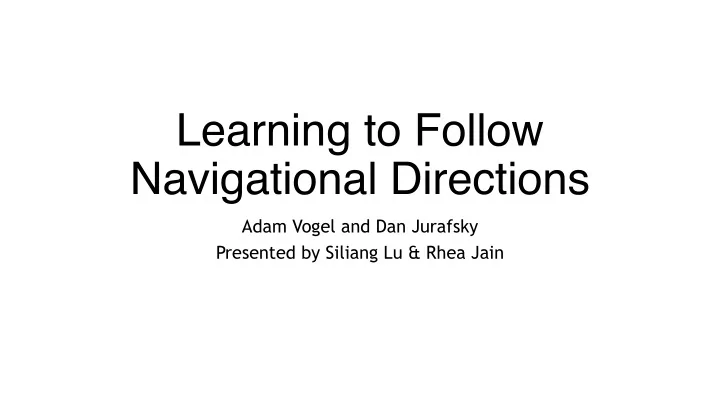

Learning to Follow Navigational Directions Adam Vogel and Dan Jurafsky Presented by Siliang Lu & Rhea Jain
Goal • Develop an apprenticeship learning system which learns to imitate human instruction following, without linguistic annotation • Learn a policy, or mapping from world state to action, which most closely follows the reference route
Dataset • The Map Task Corpus • A set of dialogs between instruction giver and an instruction follower • 128 dialogs with 16 different maps • Each participant has a map with landmarks • The instruction giver: • Having a path drawn on the map • Must communicate this path to the instruction follower in natural language Semantics of spatial language • Egocentric (speaker-centered frame of reference): “the ball to your left.” • Allocentric (speaker independent): “the road to the north of the house.”
Reinforcement Learning • Goal : Construct Series of moves in the map which most closely map the expert path • Set S :States – Intermediate Steps • Set A: Actions – Interpretative Steps • Reward Function R • Transition Function – T(s,a) • D – set of Dialogues • (l1,…,lm)- Landmarks
STATE,ACTION & TRANSITION • State • Action • Transition
Reward • Reward :Linear Combination of three features • Binary Feature indicating if expert would take same path • Binary Feature indicating the right direction • Feature which counts number of words similar to the target landmark • Policy • Measuring the utility of executing a following policy for the remainder
Features - Mixture of the World Information and linguistic Information(utterances + landmarks) Components of the Feature Vector 1.Coherence – Similar words between utterance and landmark 2.Landmark Locality – check if landmark l is closest 3.Direction Locality – Check if cardinal direction closest to the target landmark 4.Null Action – Checks if target is null 5.Allocentric Spatial – co-joins side c we pass the landmark on with each spatial term 6.Egocentric Spatial- co-joins cardinal direction we move in with spatial term
Approximate Dynamic Programming • SARSA Algoritm • Boltzmann Exploration • Actions with weighted probability • Bellman Equation • Minimize temporal difference
Evaluation • Visit Order: • The order in which we visit landmarks • The minimum distance from Pe to each landmark • order precision=N/|P| • order recall = N/|Pe|
Discussion
Recommend
More recommend